St. John’s Bible: Volume 6 – Gospels and Acts
The Gospel of Matthew
Genealogy of Jesus, Matthew 1
Matthew’s Gospel, the first book in the New Testament, begins with the genealogy of Jesus. Showing Jesus’ descent from Abraham and David connects Jesus with the Old Testament. The menorah, the seven-branched candlestick from the Jewish temple, gives form to the genealogical tree, emphasizing Jesus’ Jewish roots and that Matthew was writing to the Jewish community.
This full page illumination was the first Donald Jackson did for The Saint John’s Bible. Behind the menorah are swirling, turbulent waters, reminding of creation. As God brings order out of chaos. Jesus is bringing a new creation. The same water figure is used in Matthew 8, where Jesus calms the storm. The DNA double helix is stamped in gold on the menorah, emphasizing the humanity of Jesus, the incarnation.
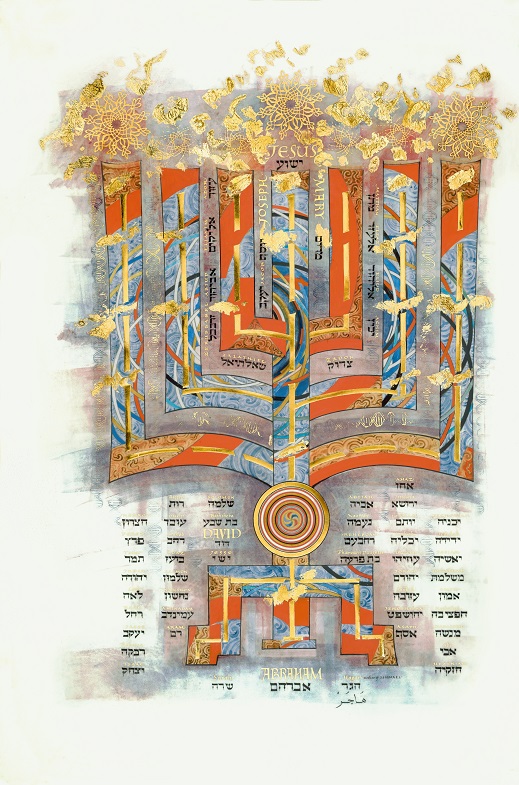
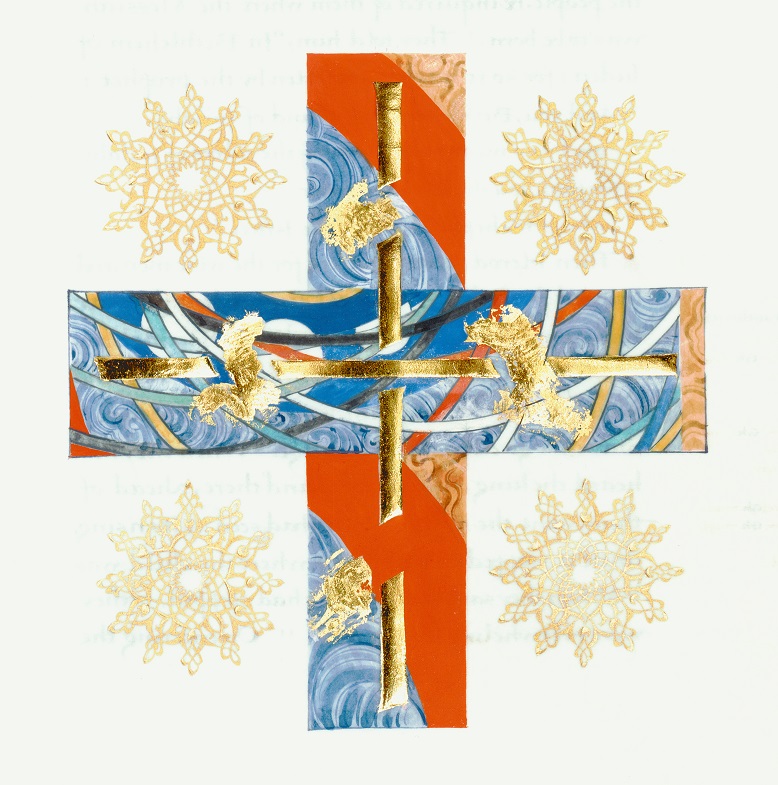
The Beatitudes, Matthew 5:1-12
Artist Thomas Ingmire also did the illumination for the text of the ten commandments in Exodus 20. There is a parallel between Moses going to Mt. Sinai to receive the Law from God and Jesus, the greater Moses, giving the Sermon on the Mount, a completed version of the law of Moses. The word “Beatitude,” which begins each of these promises of Jesus, means “blessed.” The word can also be translated “happy.”

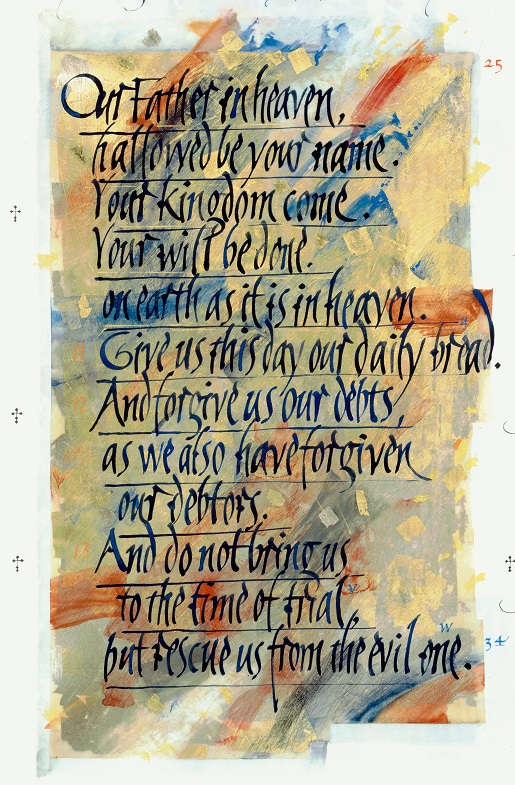
The Lord’s Prayer, Matthew 6:9-13
This illumination of the Lord’s Prayer is integrated into the text itself. In this foundational Christian prayer, all the Beatitudes come together.
Calming the Storm, Matthew 8:23-27
The five verses wherein Jesus calms the storm are bracketed by miraculous accounts of Jesus healing the sick and broken in Matthew 8 and 9. Jesus is healing the ill and disabled who come to him in these chapters because of their faith. In the roiling storm on the sea of Galilee, the disciples of Jesus also suffer a danger which they would be safe from, if they believed. Suzanne Moore’s abstract style depicts the dark and treacherous waves and the helpless boat that carry the disciples and the sleeping Jesus. When the terrified disciples finally wake Jesus and he rebukes them for their little faith, the son of God’s power is shown on full display. For, at the sound of Jesus’s words, the thunderous storm gives way to a serene calm. The second illumination shows the pale blue sea crowned with golden arcs that resemble the lofty roof of a cathedral. God’s presence dissipates the darkness and turmoil.
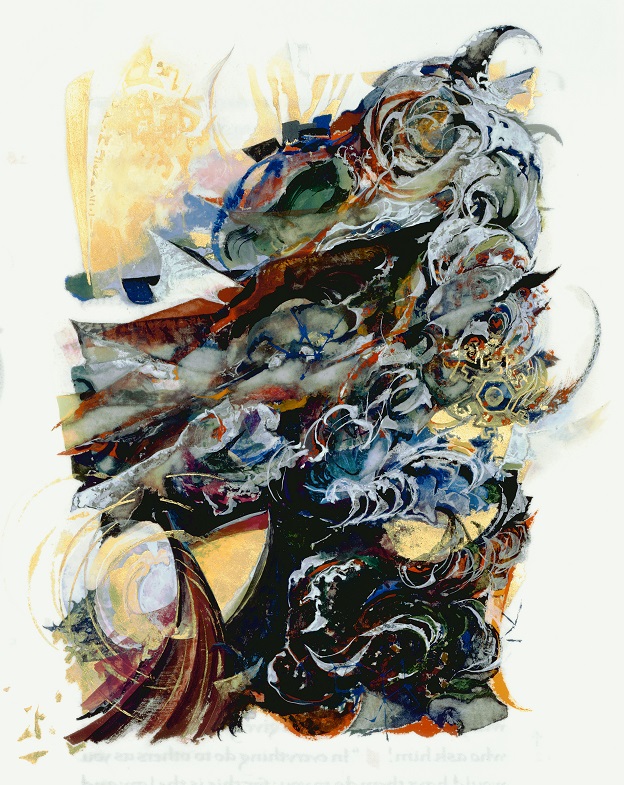
Peter’s Confession, Matthew 16:13-20
The illumination at Matthew 16 is a tryptich or a three-part image. The image relates the moment at Caesarea Philippi when Peter confesses who he believes Jesus is. Jesus askes his disciples, “Who do you say that I am?” (Matt. 16:15). Peter responds, “You are the Messiah, the Son of the living God” (16:16). Peter’s words are inscribed on the right section of Donald Jackson’s illumination, while Peter’s face, drawn in dark lines, is nestled beneath and to the left of the message. The cubist style of Peter’s features gives the effect that his face was carved from stone, a detail significant to Jesus’s next words. Jesus responds to Peter’s confession, saying, “I tell you, you are Peter, and on this rock I will build my church” (16:18). The illumination around Peter’s face also includes crosses and fragments of flags, which connect to Saint John’s Abbey and University, part of the legacy of the church, where bright flags fly at special events.
The golden head of Jesus at the center of the illumination is framed not only by a halo but also a cross. Having just revealed himself to his disciples as the messiah, Jesus’s entire figure is robed in gold, the fullest incarnation of the divine. The left section of the illumination depicts the gates of Hades, which “will not prevail against” the church (Matt. 16:18). Donald Jackson incorporates into the image elements of the historical place where Peter made his confession, at the foot of Mount Heron in Caesarea Philippi, a religious center of the Greco-Roman world. One of the sources of the Jordan River flows from a large cave at that site. The cave opening where the waters emerged was believed to be an opening to the underworld. Thus, Jesus very aptly declares there that his church shall be a stronghold against the gates of hell. The image of hell in the illumination has a representation of Assyrian gods, with the eagle-beaked, winged horse, as well as a microscopic view of the AIDS virus, which is thought to be a contemporary version of experiencing hell. The Hebrew word for the underworld (Sheol) hovers over the image.

“You Shall Love the Lord Your God,” Matthew 22:37-39
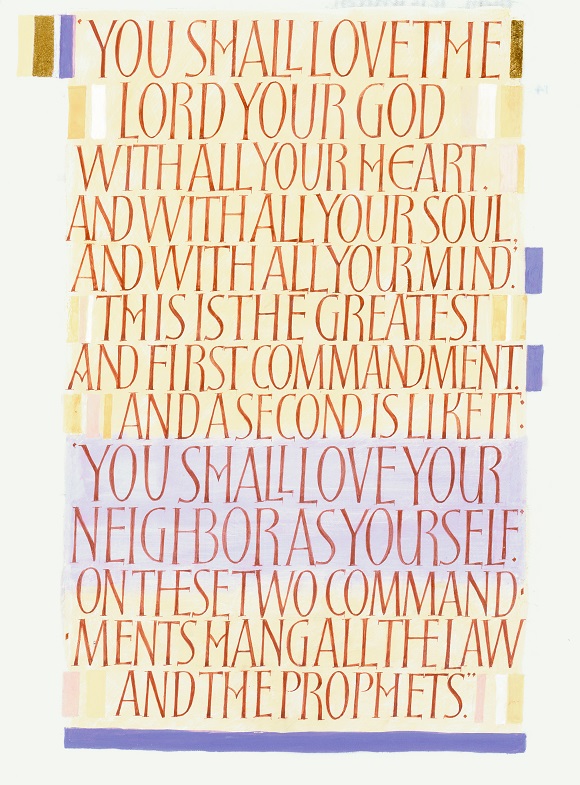
Last Judgment, Matthew 24
The final illumination in the book of Matthew depicts the impact of the incarnation on history. Jesus lays out a vision of the age to come and of his return in Matthew 24-25. Without Jesus’s incarnation and death on the cross, life is a chaotic, purposeless entanglement of sin and death, as the left section of Suzanne Moore’s image shows. Jesus’s coming ends death’s reign. The central portion of the image includes sweeping, golden arches that follow a circular motion. Some of the circles intersect to form a cross, indicating the reconciliation of God and man that happens at Christ’s crucifixion. A few of the arches extend above the small section on the right and even beyond, for the age of the Last Judgment and Jesus’s Second Coming has yet to come. For now, Christ’s followers live in the age between his resurrection and return. The church is meant to cultivate and grow, like the small and refreshing patch of green in the right corner of the illumination. Jesus’s incarnation also brought order to chaotic world, for the right side of the image uses all the colors that the left side does, except with a very different quality and effect.
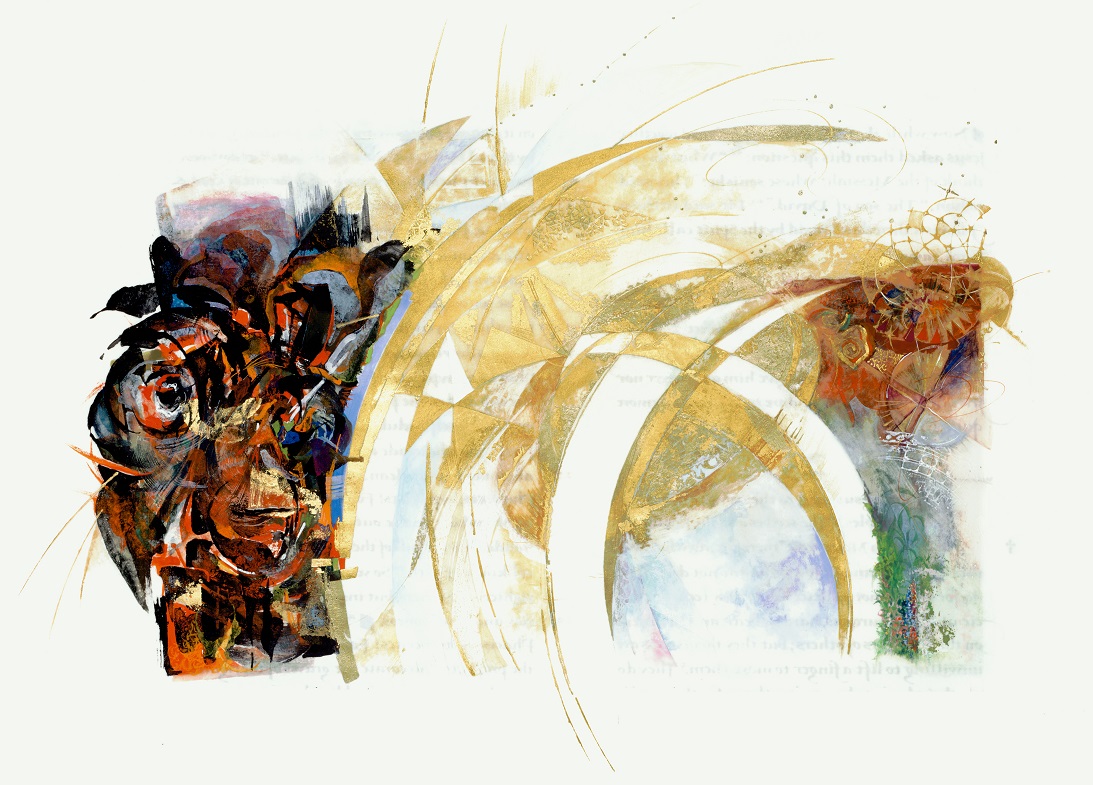
Last Judgment, Suzanne Moore, Copyright 2002, The Saint John’s Bible, Saint John’s University, Collegeville, Minnesota USA. Used by permission. All rights reserved.
The Gospel of Mark
Baptism of Jesus, Mark 1:9
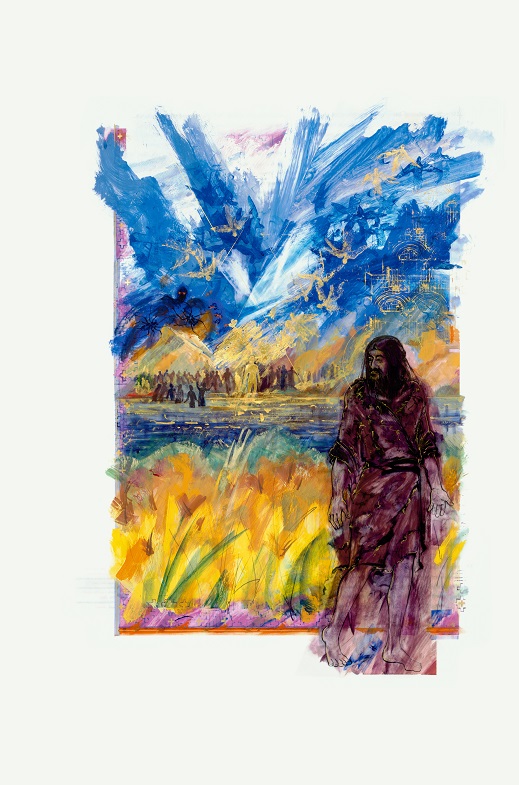
Sower and the Seed, Mark 3
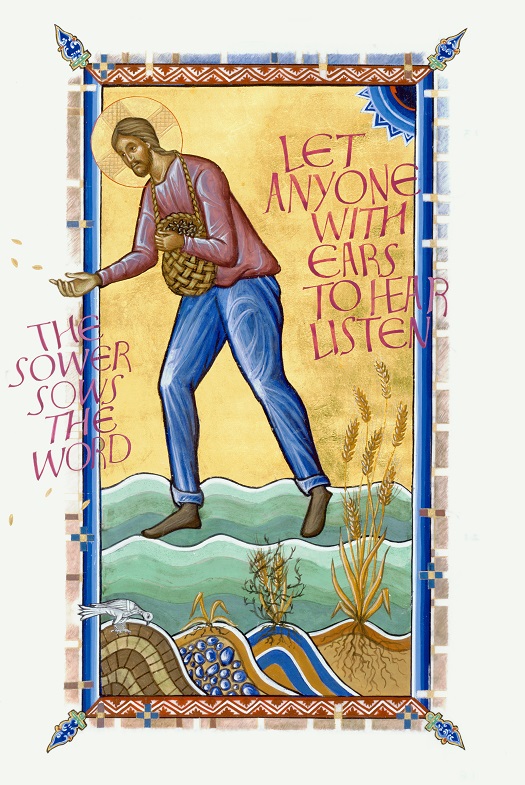
Artist Aidan Hart represents the parable of the Sower and the Seed with an icon in which Jesus is wearing blue jeans, scattering the seeds of the Gospel. A bird searches for seed on thorny ground, rocky soil, as well as fertile land. Donald Jackson and Sally Mae Joseph contribute with border decoration and calligraphy.
Two Cures, Mark 5:25-43
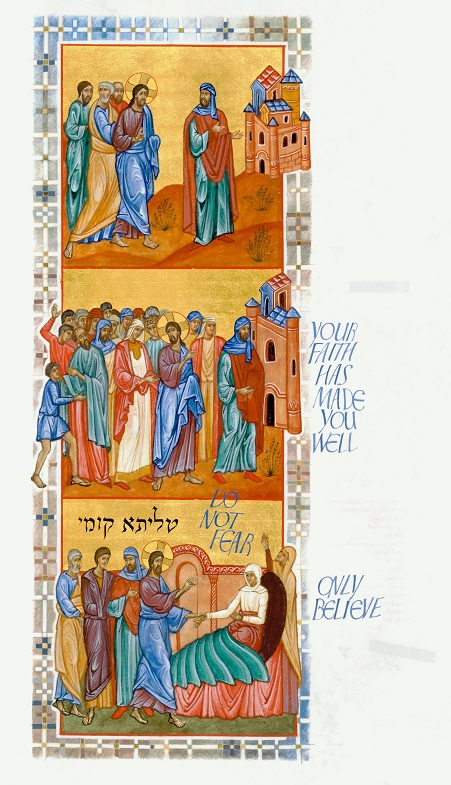
Mark 5 tells a story of faith inserted inside a story of faith. The unclean woman reached out in faith to touch Jesus’s cloak, believing she would be healed. The synagogue leader, Jairus, had the faith to seek out Jesus to heal his dying daughter. Iconography is employed in this illumination, and hand gestures and colors are significant in icons. In the top panel, Jesus makes the sign of blessing with his hand as he accompanies Jairus to the town. Jesus holds up a portion of his cloak in the second panel, for power had gone out of him there to heal the woman. In the bottom image, Jesus holds the girl’s hand and gives the sign of blessing. Above him the Aramaic words “Talitha qumi” are written, which mean “Little girl, arise.” The two women Jesus heals in this illumination wear white to signify the cleansing they have received.
Multiplication of the Loaves and Fishes, Mark 6:33-44, 8:1-10
The gospel of Mark has two accounts of Jesus multiplying fish and loaves to feed the crowds. Jesus feeds five thousand in chapter 6 and four thousand in chapter 8. As the food multiplies in the accounts, so the illumination of fish and bread multiplies across two pages, swirling around the margins of the text. The unbroken fish and loaves hold a prominent place at the top of the two pages. The loaves are rendered in gold and marked with a cross, which alludes to Jesus being the bread of life. The fish and bread images are inspired by a Byzantine mosaic from Tabgha, a location on the shore of the Sea of Galilee where tradition places this miracle. The little brown bars and angles that are scattered around the illumination represent the broken pieces of bread, and the scale-like marks represent pieces of fish. At the top of the illumination in gold text are the words from Mark 8:8, “They ate and were filled.”
The basket designs that are swirling around the image originate from ancient Native American Anasazi basketry. The presence of the designs in fish and loaves illumination suggests the exponential effects of Jesus’s miracles and his incarnation through history. God’s act of love has multiplied itself into the lives of believers and the lives of those whom believers minister to. The blue bars around the illumination that give fixed points to the image could be seen as obstacles in the multiplication of love that must be surmounted. The blank spots represent sins of omission, moments when people should act with love but do not.
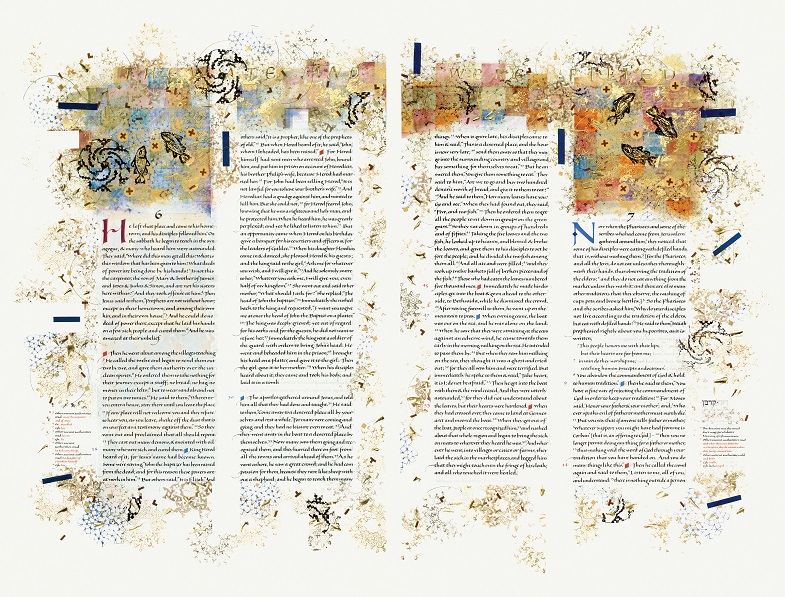
Transfiguration, Mark 9:2
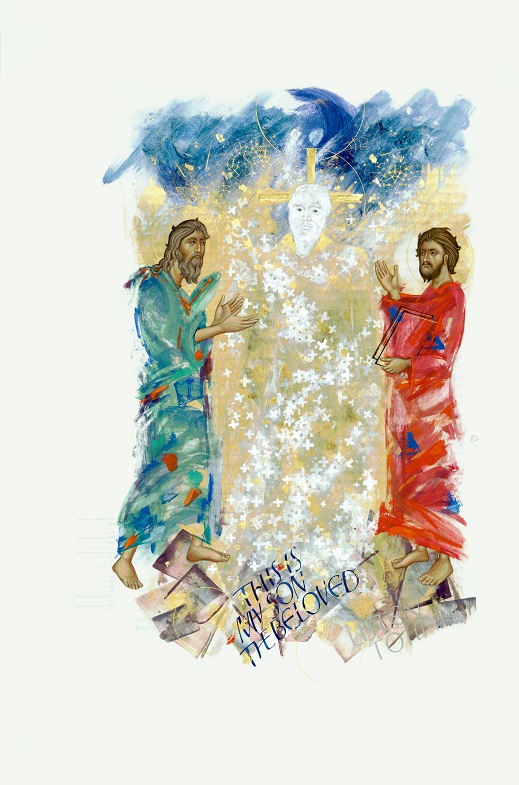
The reader views the illumination of Jesus transfigured from the perspective that Peter, James, and John may have had, since those three disciples were the only individuals to ascend the hill with Jesus at that glorious moment. On either side of Christ are Moses, who is holding the two tablets of the law, and Elijah. Both men, though they are not living on earth, are depicted with detailed human feet, standing on the ground. They lift their hands in reverence to Jesus, who is shrouded in a golden robe that is covered in crosses. This is not just Jesus in a white robe, but Jesus transfigured, his glory being revealed. His robe resembles priestly vestments. His detailed yet abstract face and his piercing gaze are what truly hold the reader’s attention. “Listen to Him” is repeated three times, first faintly at the bottom of the illumination, then on the following page, and lastly in a special text treatment by Sally Mae Joseph before Mark 12.
“Listen to Him,” Mark 9:7
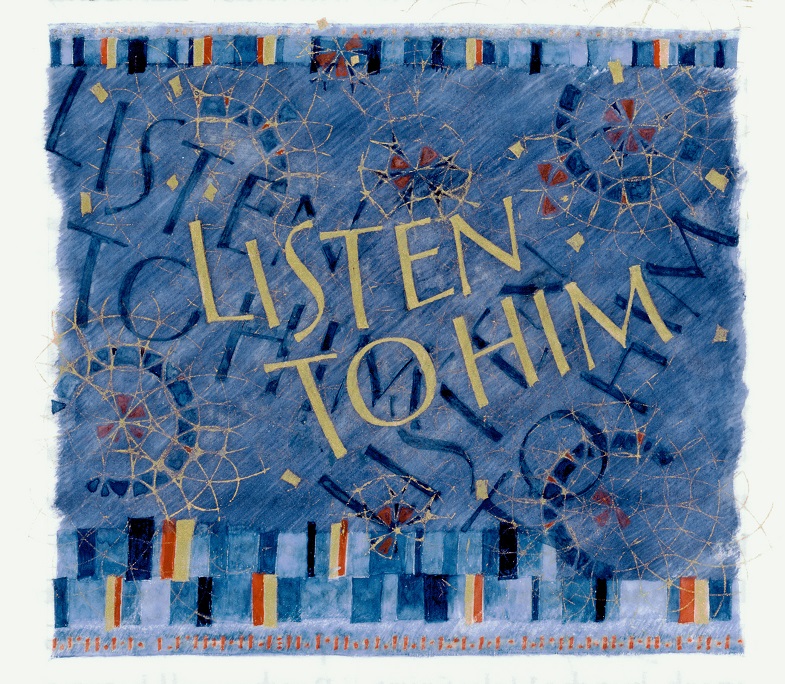
“Hear O Israel”, Mark 12:29
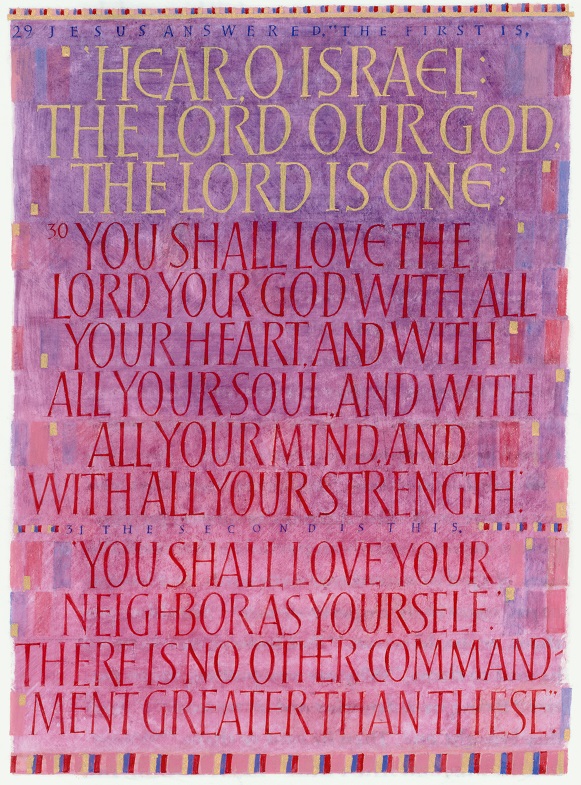
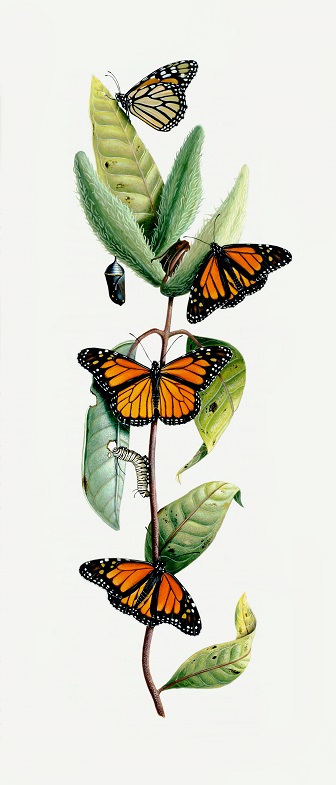
The Gospel of Luke
Birth of Christ and Luke Incipit, Luke 1:1-45
All eyes are drawn to the crib in this illumination of the Birth of Christ from the Gospel of Luke. The presence of the child is central; yet we do not see the baby. We know He is there, but He is not shown. Gold leaf, used to create a beacon of light extending to and from heaven, represents the presence and power of the Divine.
The angels are reminiscent of the angels on Jacob’s ladder (in Genesis); the stars above are from illuminations earlier of Abraham and Sarah and the Creation. All God has promised is now fulfilled. The ram reminds of the ram sacrificed in place of Isaac. The donkey is what Jesus will ride into Jerusalem on Palm Sunday. The animal in the forefront is not a mild barn cow, but rather a bull that resembles the prehistoric paintings found in the caves of Lascaux. In medieval art, each gospel writer was represented by a figure; Luke was represented by an ox.
The text draws attention to Zechariah’s prophecy in Luke 1:78-79: “By the tender mercy of our God, the dawn from on high will break upon us, to give light to those who sit in darkness and in the shadow of death, to guide our feet into the way of peace.” This is the message John the Baptist, Zechariah’s son, will bring to the world about Jesus.

The Magnificat, Luke 1:46-55 Child Will Be Holy, Luke 1:35
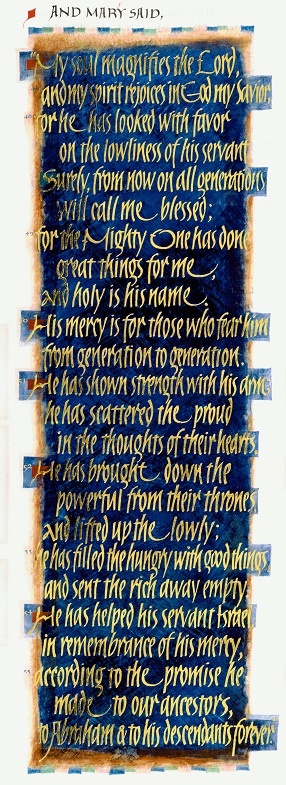

“Blessed be the Lord God of Israel,” Luke 1:68-73
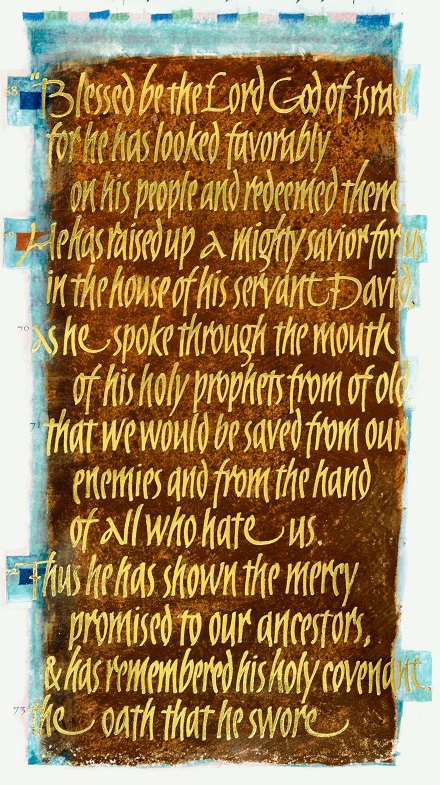
“Glory to God in the Highest,” Luke 2:14
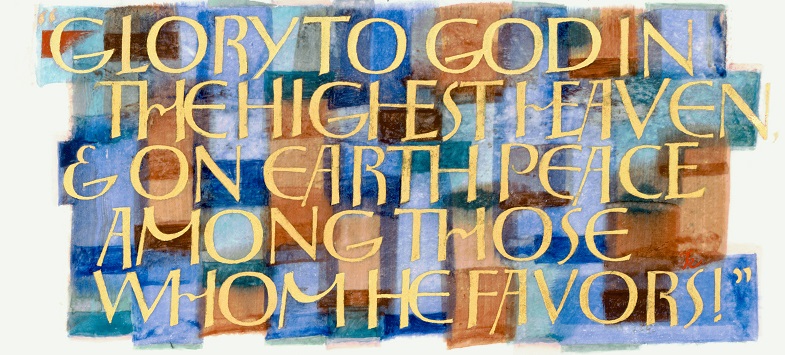
Simeon’s Prophecy, Luke 2:29-32
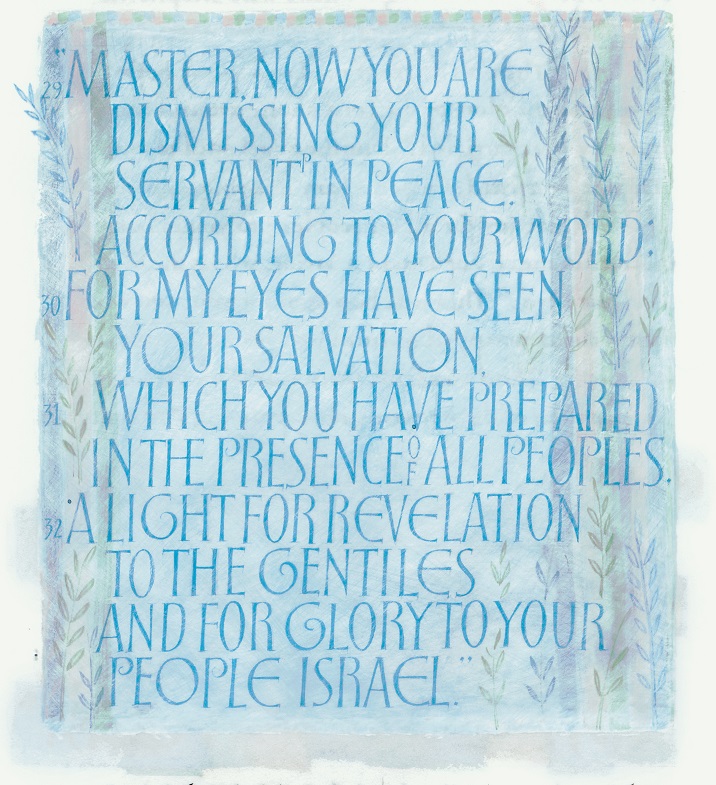
Dinner at the Pharisee’s House, Luke 7:36-50
The illumination by Donald Jackson depicts a scene at the house of the Pharisee, Simon, who invited Jesus to dinner. A woman of the street interrupted the dinner to bathe, anoint, and kiss Jesus’s feet. The right side of the image shows the chaos the woman caused and the dinner items she upset when she entered the religious leader’s home. The left side of the illumination shows the woman kneeling, her focus absorbed by her task of anointing Jesus’s feet. The words of Jesus in the middle of the scene mediate the chaos and her unselfish act of love. A dark partition divides the sinful woman’s world from the religious world of the Pharisees. She is dressed in colorful, unconventional colors. Meanwhile, the white scarf stretched across the dinner scene have Hebrew words related to rituals of temple sacrifice written on it. The customs of the Pharisees exclude people on the margins of society, like this woman. Yet Jesus sees in her what the Pharisees never showed him – unashamed love and gratitude for the forgiveness of sins that the Messiah grants.
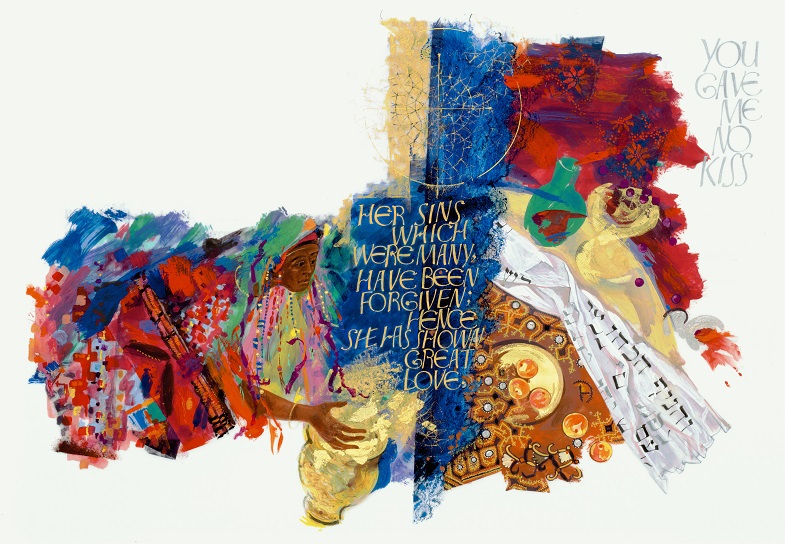
Luke Anthology, Luke 10; 15; 16
Artist Donald Jackson illuminates five parables and one story found in the Gospel of Luke:
-
- the lost sheep
- the lost coin
- the prodigal son
- the Good Samaritan
- the rich man in Hell and Lazarus in Abraham’s bosom
- the story of Mary and Martha.
The parables reveal God’s love for sinners. All the lines in the illumination point upward to Christ on the right.
The World Trade Center Towers are in gold in the Parable of the Prodigal Son. Donald Jackson was working on this illumination on September 11, 2001. He placed the image in the Prodigal Son panel to illustrate the challenge to forgiving evil.
The right hand panel of Mary and Martha continues the focus on Christ and his words to Mary as she sat listening to His teaching that “there is need of only one thing.” (Luke 10:42).
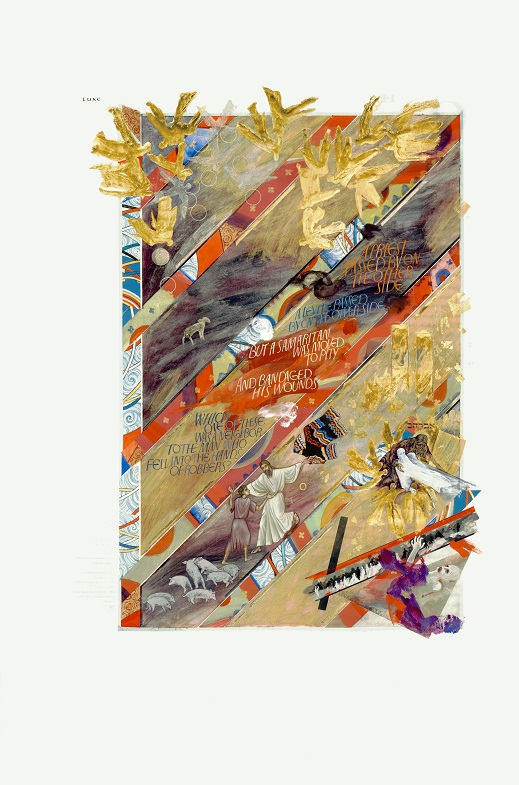
Jesus with Mary and Martha
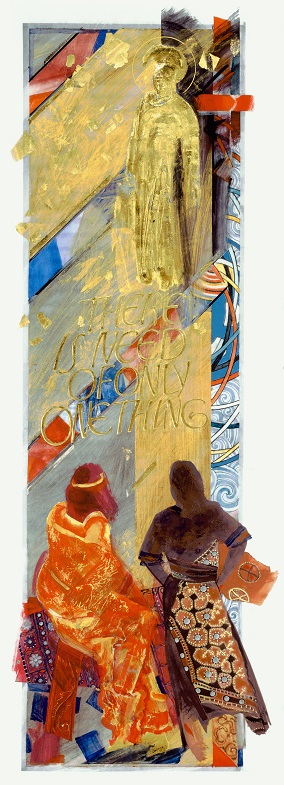
The image of Mary and Martha looking up at Jesus is a continuation of the “Luke Anthology” illumination on the opposite page. Mary is seated on the left, attending eagerly to the words of her Lord. Martha, on the right, stands in her apron, impatiently placing her hands on her hips. The two sisters represent two different approaches to care and hospitality: Mary loves Jesus by focusing all her attention on his teaching, while Martha shows her care by preparing a clean home and satisfying meal. Jesus’ words to Martha when she complains of Mary’s idleness are placed in the center of the image. He tells Martha that she is worried by many things and that “only one thing” is needed – unfaltering faith to follow the Christ.
Eucharist, Luke 22
Unlike other depictions of the Last Supper that depict the disciples partaking of the Passover meal with Jesus, this illumination focuses solely on the eucharistic elements. The image draws out the connections between the Passover meal that Jesus and his disciples are sharing and the Eucharist that Christians now celebrate. The first panel shows the unconsecrated bread and wine. The middle panel depicts the lamb that is central to the Passover meal and is also the representation of Jesus as the sacrificial lamb. A stream of blood falls from the golden lamb into the cup of wine, thus emphasizing the mysterious nature of partaking of Jesus’s body and blood. Jesus tells his disciples as he dispenses the bread and wine, “This is my body…This is my blood” (Luke 22:19, 20). The last panel is the image of the ciborium, a chalice-like vessel, which is used for distributing the Holy Communion and for reserving the consecrated particles. By coming to the table to receive the Eucharist, Christians are sharing in a meal and in a sacrifice to the Lord. The three panels are divided by two stamped borders, one including the six-sided star of David and the other the cross of Christ.
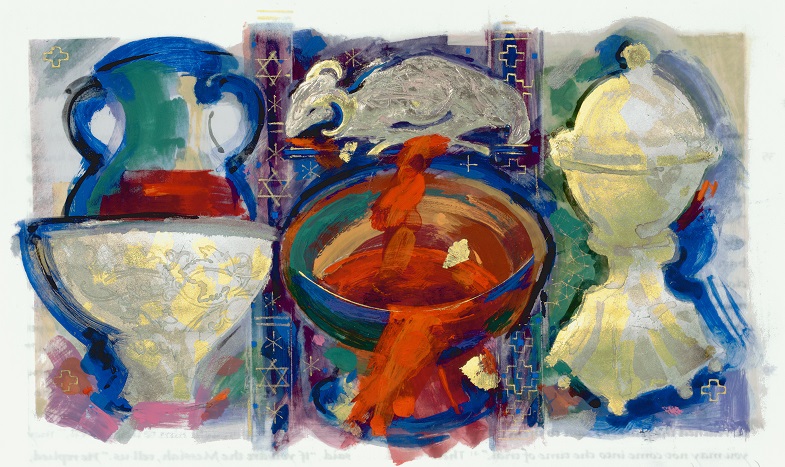
“Father, into Your Hands,” Luke 22:36

The Crucifixion, Luke 23:26-49
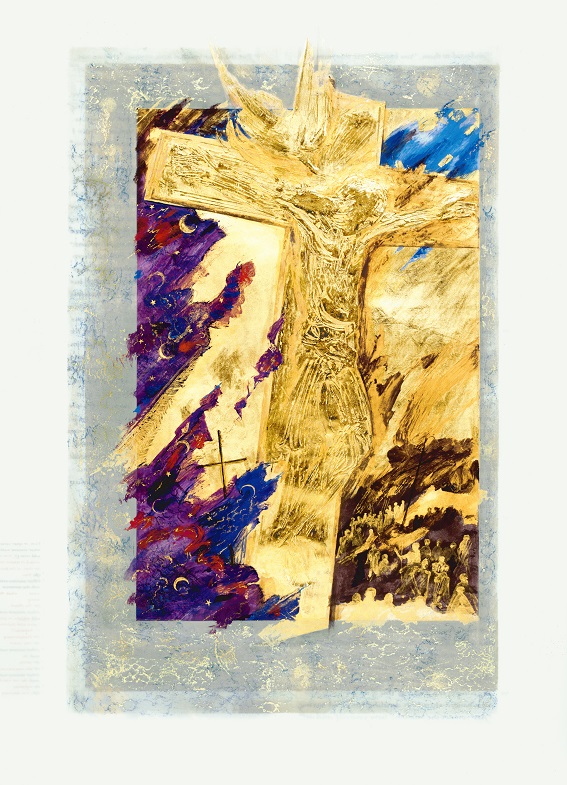
This image of the crucifixion depicts Christ’s death breaking through the darkness, defeating the forces of evil and death. Gold leaf is used to show Jesus’ divinity. Here the gold radiates from the cross; showing the crucifixion with all its pain does not diminish God’s glory.
On the left, the night sky shows the three hours of darkness. The many moons reflect that the crucifixion brought an end to time (Our time is dated B.C., before Christ, and A.D., anno Domini, the year of the Lord). The shreds of purple could reflect the tearing of the veil in the temple at Jesus’ death, the end of the earthly separation from God. Purple, the color of royalty, could also show the destruction of worldly kingship and the establishment of Christ’s kingdom. Smaller crosses on either side reflect those crucified with Jesus.
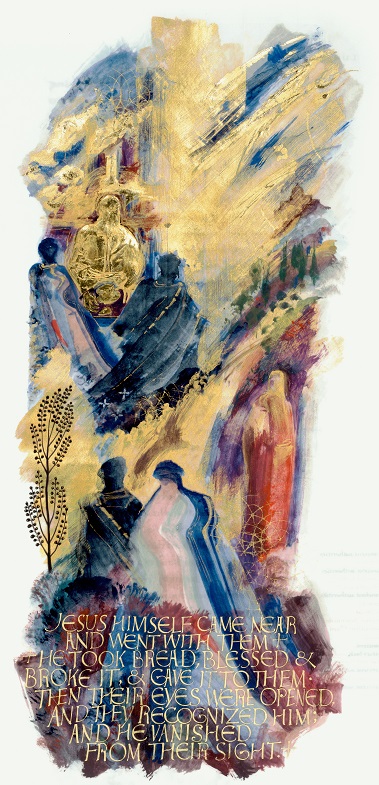
Road to Emmaus, Luke 24
Two disciples walking along the road to Emmaus are discussing Jesus’ death when they are joined by a stranger. They don’t recognize him as Jesus, but he explains from the prophets the death and resurrection. The story proceeds from bottom to the top of the picture. The disciples don’t recognize him until they sit at a meal together and he breaks the bread. Gold again looks to deity and Jesus’ resurrection. The tree along the road is reminiscent of the tree of life, from Genesis to Revelation.
The Gospel of John
The Word Made Flesh – Johannine Prologue, John 1:1-14
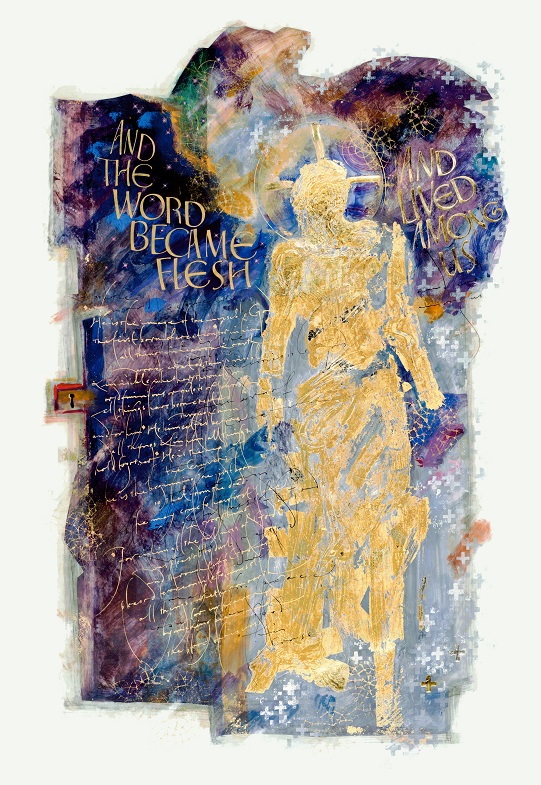
The opening of John’s gospel connects with the opening of Genesis, showing Jesus is the bringing a new creation. The image of Christ steps from the darkness, recalling the chaos and nothingness of the creation story, and moves toward light and order. The image behind Christ’s head is from he Hubble telescope, reflecting the cosmic character of Jesus’ incarnation.
The text on the left expands on the Word becoming flesh and is from Colossians 1:15-20:
He is the image of the invisible God, the firstborn of all creation; for in him all things in heaven and on earth were created, things visible and invisible, whether thrones or dominions or rulers or powers – sll things have been created through him and for him. He himself is before all things, and in him all things hold together. He is head of the body, the church. He is the beginning, the firstborn from the dead, so that he might come to have first place in everything. For in him all the fullness of God was pleased to dwell, and through him God was pleased to reconcile himself to all things, whether on earth, or in heaven, by making peace through the blood of his cross
Call of the Disciples, John 1:35-51
The passage in John 1 in which Jesus calls his disciples begins with John the Baptist declaring who Jesus really is – “the Lamb of God” (John 1:36). Jesus’s pearly white figure is not the first element of the illumination to catch the viewer’s eye, but his halo and processional cross are distinct at the center of the image. The white, celestial color of the flying angels above connect to the image of Jesus in the center and the white lamb lying in the right, bottom corner of the illumination. The elements of the Eucharist are also hidden in the bottom right corner, the loaf stamped with a red cross and the wine shown in the red background. John the Baptist’s words declaring Jesus’s nature are at the bottom of the image: “Look, here is the lamb of God.” The entire illumination depicts the crowds that were enthralled by Jesus and the few whom he called to be his disciples.
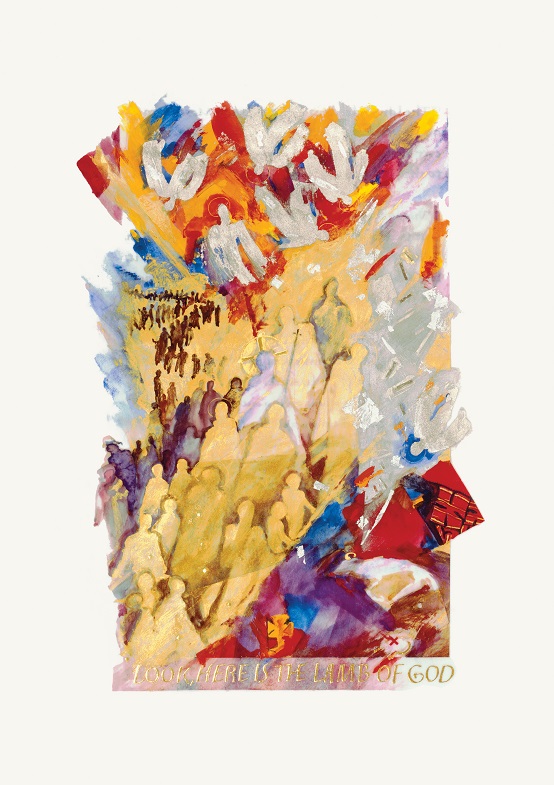
Call of the Disciples, Donald Jackson, Copyright 2002, The Saint John’s Bible, Saint John’s University, Collegeville, Minnesota USA. Used by permission. All rights reserved.
I Am Sayings, John 6:25-40; 8:12-20; 10:7-18; 14:6-14; 15:1-11
This illumination by Thomas Ingmire centers on five descriptions Jesus gives in the gospel of John to express his own identity. To the crowds whom he had fed by multiplying loaves, he declares himself to be “the bread of life” (John 6:35). He tells the people and the Pharisees at different times that he is “the light of the world” (8:12) and “the gate for the sheep” (10:7). At the last supper with his disciples, Jesus tells them, “I am the way, the truth, and the life” (14:6) and “I am the true vine” (15:1). Each statement reveals more of who Jesus is as the savior of the world. The five vertical columns in the image represent Jesus’s five sayings, and as the columns rise, they send up sparks like a firework show. The illumination makes a parallel to the Old Testament as well. As Jesus declares his nature by these “I am” statements, so God said to Moses in Exodus 3:14, “I AM WHO I AM.” The Hebrew word for this declaration God gave is YHWH, the holy name of the Lord God, which is seen at the base of Thomas Ingmire’s image in blockish lettering.
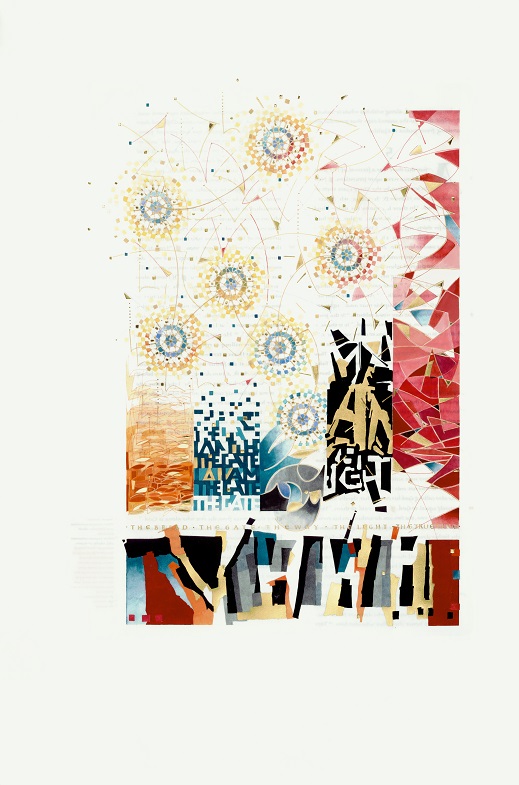
Woman Taken in Adultery, John 8
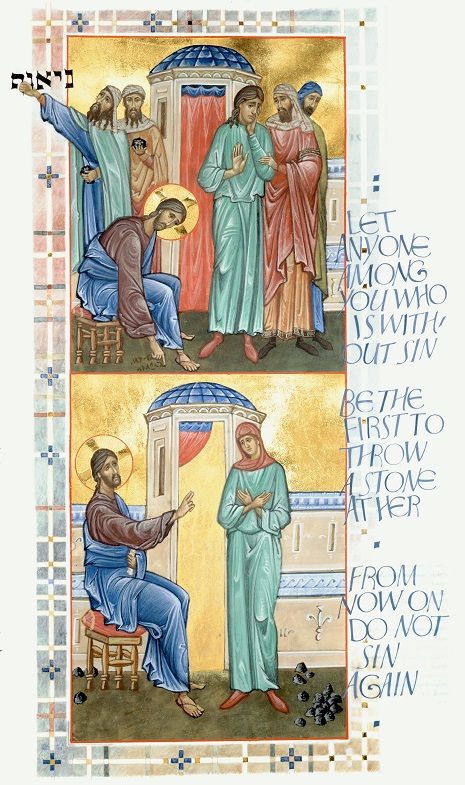
This illumination shows a return to Orthodox-style iconography. A comparison of the two panels reveals the entirely of the adulterous woman’s encounter with Jesus. In the first panel, the Pharisees have brought the woman caught in adultery to Jesus for judgment. The woman’s hair is uncovered, and her body language portrays her fear and pleading. One Pharisee holds the Hebrew word for adultery high above his head and outside the border of the panel, a position which shows a weaponized use of the Law but also points to our own involvement in the judgments being made. We the readers are just as guilty of judging others, as indicated by the Pharisee behind Jesus who is looking directly out of the frame and holding a stone out to us. Jesus is unfazed by the heated accusations being made as he draws his finger through the sand at his feet. The second panel show the accusers gone, their stones scattered on the ground. The woman’s face and hands show gratitude and repentance, her head being covered now. The curtain that previously blocked the doorway behind Jesus has now been moved aside. Jesus extends the hand of blessing to her, inviting her into the new life beyond the golden doorway. The reader now identifies with the woman, for God’s forgiveness is the only doorway into new life.
Raising of Lazarus, John 11
The viewer of this illumination stands in the tomb with Lazarus, who has just risen from the dead, and looks through the light-flooded tunnel to Jesus’s small figure in the distance. As told in John 11, Lazarus was a friend of Jesus and was in the tomb four days. Though Mary and Martha, Lazarus’s sisters, entreated Jesus to come and heal their brother when he was very ill, Jesus intentionally waited a few days before coming, for he knew that Lazarus’s illness was “for God’s glory so that the Son of God may be glorified through it” (John 11:4). The illness and death of Lazarus did proclaim God’s glory, for Jesus resurrected his friend, showing by awesome miracle that he is “the resurrection and the life” (11:25). At the left side of the illumination, behind Lazarus, is the detailed body and wings of a dead-head moth, representing the darkness from which Lazarus, like all those who trust in Christ, has been saved. The strips of cloth from Lazarus’s shroud cascade around as they fall off the man renewed with life. Jesus stands afar with a gold swath behind him that rises up to heaven, indicating the Heavenly Father who had sent him.
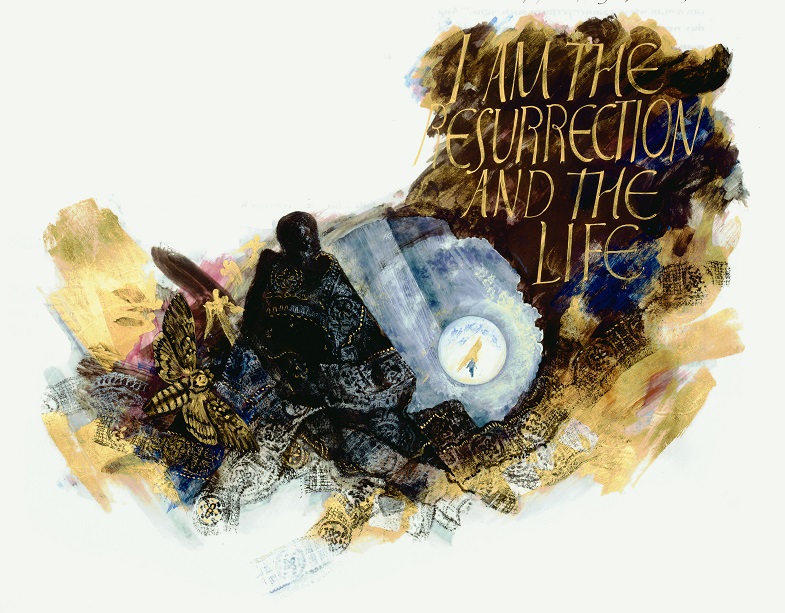
John 11:25-26
Those Who Believe, Donald Jackson, Copyright 2002, The Saint John’s Bible, Saint John’s University, Collegeville, Minnesota USA. Used by permission. All rights reserved.
The Resurrection, John 20
The final illumination in the book of John shows Jesus revealing himself to Mary, who is the first to see Jesus resurrected and who is the messenger of the good news to the disciples. Mary’s detailed face and garments are red, reflecting the divine glory of her Savior, now risen from the dead. Though Jesus is turned away in the image, the viewer sees him in Mary’s response. She reaches a hand up to embrace his face, wanting to hold on to the Jesus she knows and loves, but the hand is translucent. As Jesus tells her, he is bound for the Father’s side so that the fullness of the resurrection may be brought to mankind. The Aramaic word for rabbi, “Rabbouni,” is written next to Mary. The Committee on Illumination and Text for the Saint John’s Bible chose the Aramaic rather than the Hebrew spelling to draw a connection to the Syrian church, one of the oldest Christian churches. The Syrian translation of the Bible is the closet example we have of the language actually spoken by Jesus and his disciples.
In the distant left of the image, the three crosses on Golgotha stand. Behind Mary two figures in white – the angels – stand outside the empty tomb. The left side of the entire illumination is stamped with patterns from the carpet pages at the end of the gospel, indicating that this moment is an end of Jesus’s ministry on earth. But the pattern trails off on the right side, and patches of vivid yellow tell of the light of God’s kingdom that is coming to dawn upon the earth.
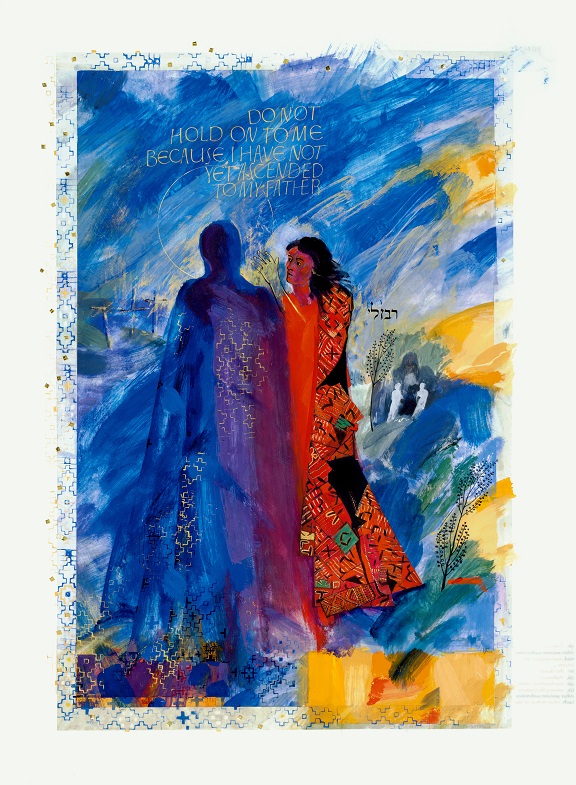
Acts
“Repent and be Baptized,” Acts 2:38

Pentecost, Acts 2

The illumination of the descending of the Holy Spirit upon the disciples shows the beginnings of Christianity as well as allusions to the Saint John’s Abbey and University, which sponsored the making of The Saint John’s Bible. When the Holy Spirit came upon the disciples, Jews had traveled from everywhere to Jerusalem to celebrate the Jewish feast of Pentecost, which was fifty days after Passover. The city of Jerusalem rises, bathed in gold, from the ground in the image, and the high modern walls of Saint John’s Abbey Church are seen behind Jerusalem. The overlap of the city and the church highlight the scope of the Christianity’s outreach from its beginning until now. A column of golden smoke and fire ascends in the middle of the image, and the sun and the moon are shown on the right and left of the column. Between the sun and moon is a cross, like the one at the top of Saint John’s Abbey. Streaks of red flame dart across the page, like the “tongues, as of fire” that rested on each disciple when the Holy Spirit filled them (Acts 2:3). The keys of Peter elevate above the group of small dark figures proclaiming the gospel of the inhabitants of Jerusalem. The outlined individuals at the base of the image represent people at a Saint John’s University football game, according to Donald Jackson. The colorful flags being flown are seen on the Saint John’s campus on occasion.
Life in Community, Acts 2:43-47
The illumination of followers of Christ living in community draws on Eastern Orthodox iconography. Behind the curved row of disciples and followers are details that connect the image to its contemporary setting. The deer and the various trees link the early church to the Saint John’s Abbey. Depictions of the abbey on the right as well as the Stella Maris Chapel, a chapel located on Lake Sagatagan, also are in the background. Icons of the Pentecost typically show the community of the twelve apostles seated in a curve row. In this illumination, Mary is seated in the center. Peter is at her right hand, and Paul at her left. Six apostles follow Peter and Paul on each side, then other saints of the church, who represent faithful followers throughout Christianity’s history. At the center of the image is a table with the elements of a feast as well as an altar upholding the Scriptures and the Eucharist. Above the seated figures is the image of Jesus Christ himself, holding a book with the words, “I AM” written in it. This name reveals Jesus’s true identity as a part of the trinity with God the Father and the Holy Spirit. He is seated on rainbows, with angels flanking him, and the Greek letters on either side of his head represent his name, Jesus Christ.
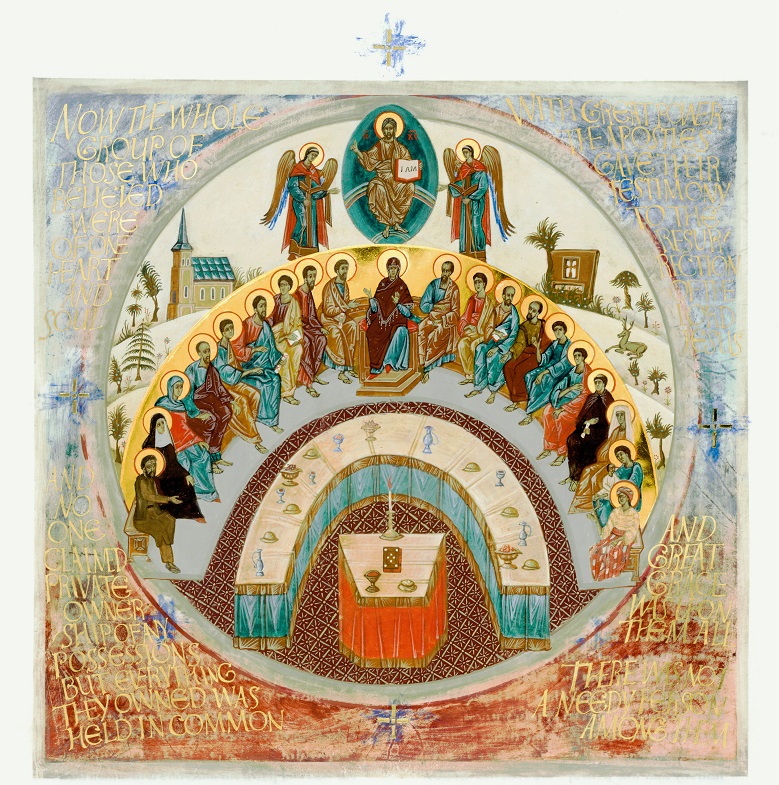
Life of Paul, Acts 9; 15; 17; 22:25-28
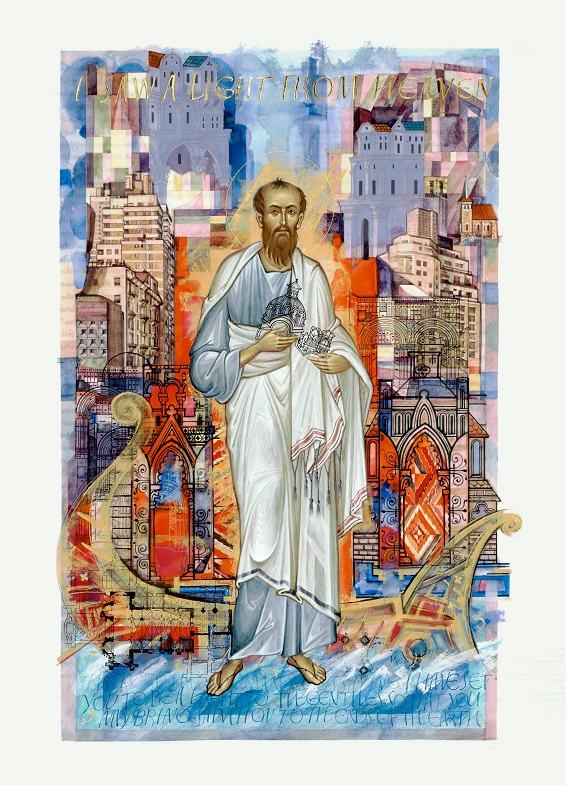
Life of Paul, Aidan Hart with contributions from Andrew Jamieson, Copyright 2002, The Saint John’s Bible, Saint John’s University, Collegeville, Minnesota USA. Used by permission. All rights reserved.In this image, Paul’s face and pose are much like a Byzantine icon. He rests against a ship, symbolizing his travels in the Roman Mediterranean. Paul’s was an urban ministry, and the buildings, both ancient and modern, reflect the many cities to which Paul brought the Gospel. In his hand Paul holds St. Peter’s Basilica, the center of the Roman Catholic Church today. The gold inscription at the top, “I saw a Light from Heaven,” is from Paul’s defense to Herod describing his conversion on the Damascus road (Acts 26:13). The bottom inscription is from Acts 13:47, where Paul turns to the Gentile mission: “I have set you to be a light for the Gentiles so that you may bring salvation to the ends of the earth.”
To the Ends of the Earth, Acts 1:8; 13:47
Acts ends with the Apostle Paul in Rome, the center of the ancient classical world. He had fulfilled his commission to bring the Gospel to the “ends of the earth.” The illumination in the lower left hand corner is based on the photo of earthrise taken by Apollo VIII, Christmas 1968. The right hand features Christ’s words in Acts 1:8, “You will be my witnesses in Jerusalem, in all Judea and Samaria, and to the ends of the earth.”

